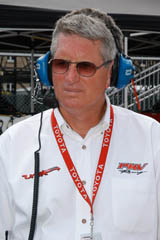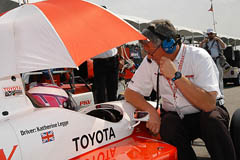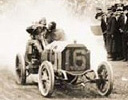Jim Griffith: A Study In Adaptation
Just like in nature, to survive in the racing world, you have to constantly adapt to the environment or perish. Whether it's adapting to the changing track conditions during a race or the changing pressures during a race season or the changing landscape over the years, you must adapt if you expect to stick around very long in this cruel sport.
 Jim Griffith (Photos by .)
Jim Griffith (Photos by .)
Jim Griffith, one of the owners of the Polestar Racing Group, knows all about adapting. From building race cars to engineering race cars to owning race teams, he's been doing it for decades, and he's been very successful at it.
I first heard about Griffith when he was producing Super Vee cars, a series and a class that are long gone.
"We did a couple of different Super Vees," Griffith said. "We did a GR002 which was done in '82 and '83, somewhere in those ranges. Then we built another one after that which was the 006. That one was the last one I did. There are a bunch of them still running. There are about eight or nine of those cars still running around the country."
Next came an Atlantic car in the days when you could still produce your own chassis. This was no ordinary Atlantic car, as the goal was to make a quantum leap forward in technology for this class. Unfortunately, it was an under funded effort.
"Then, I did the Raven Formula Atlantic car," Griffith said. "That was an all carbon fiber tub. It was a neat project.
"I'm really grateful for the opportunity. We basically built 2-1/2 cars and ran for two years on $300,000, including building the cars. It was a one man band. I had a lot of help from my friends. That's the project I went from the drawing board to CAD. The gentleman put the money up for the project and told me to do it all in CAD. I basically learned how to do CAD and build the car at the same time. It was one of those things that never quite completed. We talked about building a new car with some better backing."
The better backing never came along and eventually the rules changed in the Atlantic series, going to a spec chassis built by Swift Engineering. Griffith had to adapt, and became an engineer for the cars instead of a builder. The drivers he worked with are a Who's Who of open wheel racing.
"We went and did some Ralt stuff in '95, '96, and '97. I did Patrick Carpentier's engineering in '95 and '96, Alex Barron in '97, and Buddy Rice, Memo Gidley in '98, and Buddy Rice again in 2000. Basically, I became more of an engineer than a builder, and that was the way things were going."
So, how does Griffith like being more of an engineer than a builder?
"There's really two different disciplines, especially in a class like this that is so tightly defined," he said. "When you used to build your own car, you go ahead and say okay well we have a new problem, okay we change the suspension geometry, make it wider, change the mounting point, do what you need to do. Now, it's how do we get this done? So, it's springs, sway bars, brakes, you are a lot more limited in what you can do. And sometimes you have to get creative in how you approach things, but it's pretty neat.
"Definitely in this economy that we are in, you kind of need a platform like this right now. Back then when you could change all that, when I was at Lynx back in '95 through '99 there wasn't much that was a Ralt. We had all of our own suspension, our own uprights, our own bodies, everything. We'd do 40 days of testing a year, and now we do ten. It's a lot different."
Different, but is a spec series better or worse?
"I think if you could take the economics out of it, I think racing is worse for it. The open formula was pretty amazing. What you could do and what you could get done. But when the economy just won't support it, you have to go back to whatever you have to do. I've gone from being the guy who didn't want any control to being the guy who really believes in control because I always feel you can relieve the control. If you can get the series healthy again and you feel you can open it up again, you can. But if you don't get it under control to begin with, it will just stay out of control. It will spiral, and before you know it, you are out of business."
Then, how does Griffith like developing drivers rather than cars?
 Jim Griffith in his latest role as a team owner, developing drivers. At Cleveland in 2005, he provides instructions to his driver at the time, Katherine Legge.
Jim Griffith in his latest role as a team owner, developing drivers. At Cleveland in 2005, he provides instructions to his driver at the time, Katherine Legge.
"We always develop drivers. If you look at it, we just developed drivers and cars at the same time. Now, we just eliminate the car part. When Patrick [Carpentier] came up, he was really raw. When Alex [Barron] came up , basically he was just out of karts. Really, Buddy Rice was the same. We always were developing drivers. We just were able to let them learn how to develop cars on a grand scale at the same time. I do think that some of the new guys are missing that. Missing that opportunity. Again, it goes back to the economics. If you didn't get the economics under control, they would have no opportunity."
Griffith adapts so well, he sometimes strays away from open wheel cars.
"Occasionally we strayed off the open wheel car," he said. "We've done some other side projects. We just got done building a Lotus Europa, like an E Production car. It's the wildest little thing you ever saw. It would fit under this table. It's a pretty neat car. It's been quite a project. So, we've strayed away from it occasionally."
Jim has a perfect partner in his wife, Pam. She has been the expert in team organization, management, marketing, and PR work. In fact, when Jim was off building and engineering cars in the Atlantic series, she was the team manager for Pro Formula Ford 2000 efforts, at times five teams in the same year. Along with the husband and wife duo, Bruce Potter, an engineer, is also a co-owner of Polestar.
With this sort of background and skill set, is Polestar ready to make the leap up to Champ Car? This is what Jim said last year in Toronto, which coincides with what has been written this year:
"The Champ Car thing is really just a matter of the budget and the timing. We've actually gotten pretty close a couple of times. But for us, it's a business, and we have to make it make economic sense. So, I think in 2007 it's something we are looking at. It's a project we want to do. We keep building our infrastructure up. We keep getting better equipment, better awnings, and hiring better people with that in mind." Then, he added a bit of humor, "Every year we get dumber, so we might get closer to doing it."
Knowing Jim Griffith's ability to adapt and his proven record in the racing world, the rest of the Champ Car teams better watch out if Polestar does indeed move up.
Copyright © 2006 by Russell Jaslow and Deep Throttle. All Rights Reserved.
|




